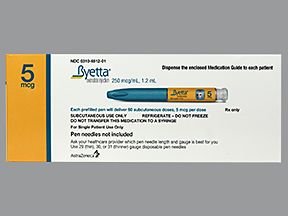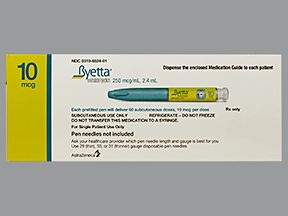The usual Byetta dosage for high blood sugar is 5 to 10 micrograms (mcg) twice per day. Specific dosages may vary depending on any side effects you experience or other conditions you may have.
Byetta is a prescription injection that’s used to manage high blood sugar. It’s used along with exercise and diet to treat type 2 diabetes in adults. The drug is injected twice per day.
The active ingredient of Byetta is exenatide. It belongs to a group of drugs called glucagon-like peptide-1 receptor (GLP-1) agonists.
This article describes the dosage of Byetta, as well as its dosing frequency, form, strengths, and how to inject it.
Your doctor will likely start you on a low dosage and adjust it over time to reach the right amount for you. They’ll ultimately prescribe the smallest dosage that provides the desired effect. Be sure to use the dosage your doctor prescribes for you.
Byetta form
Byetta comes as a liquid solution in an injection pen. Each pen has 60 doses.
Byetta is given as an injection under the skin. You’ll give yourself injections in your upper arm, abdomen, or thigh.
Byetta strengths
Byetta comes in two strengths:
- 5 mcg per dose in 1.2 milliliters (mL) of solution
- 10 mcg per dose in 2.4 mL of solution
The typical starting dose of Byetta for type 2 diabetes is 5 mcg. The dosing frequency is twice per day. You’ll use this dosage for 1 month to see how well it manages your blood sugar levels. Depending on how you respond to Byetta, your doctor may increase your dosage to 10 mcg twice per day.
You should inject your Byetta doses one hour before each of your two main meals (for example, breakfast and dinner). The two doses should be at least six hours apart. If you don’t eat much for breakfast, you could inject your first dose one hour before lunch.
Once you decide when to have your two daily doses, try to stick with this schedule. This will help keep your blood sugar levels steady throughout the day.
If Byetta isn’t effective for you, or you experience serious side effects, your doctor may decrease your dosage or switch you to a different drug.
Byetta is injected under the skin in your upper arm, thigh, or abdomen. You’ll give yourself Byetta injections at home after your doctor shows you how to use the self-injection pens. You can also follow these step-by-step instructions.
Here are a few tips for giving yourself Byetta injections at home:
- Be sure to wash your hands before handling your Byetta pen and needles.
- Gather your supplies (alcohol swab, Byetta pen, needle, needle disposal container) before you start.
- Check to make sure you’re using the correct pen for your Byetta treatment.
- Use a new needle each time you inject Byetta, and dispose of the old needle properly after use.
- Rotate your injection sites between your upper arm, abdomen, and thigh.
- Keep track of when you inject your doses, and try to stick to the same schedule each day.
Be sure to follow your doctor’s dosing instructions carefully when giving yourself a dose. If you still have questions, ask your pharmacist to show you how to use the injection pen.
Is Byetta used long term?
Yes, Byetta is typically used as a long-term treatment. If you and your doctor determine that Byetta is safe and effective for you, it’s likely that you’ll use it long term.
Below are answers to some frequently asked questions about Byetta. If you have other questions about the drug, talk with your doctor or pharmacist.
Is Byetta used for weight loss? If so, what’s the dosage?
No, Byetta is not approved for use as a weight loss drug. But because Byetta is used along with a healthy diet and exercise program, you may lose weight while using the drug.
Byetta can also cause loss of appetite as a side effect. This may lead to weight loss.
It’s important to monitor your blood sugar levels closely during your Byetta treatment. Losing weight and using Byetta along with diet and exercise changes can reduce your blood sugar levels. But it can be dangerous if your levels drop too low.
If you have questions or concerns about losing weight during your Byetta treatment, talk with your doctor.
Is there a weekly dose of Byetta I could use instead of daily doses?
No. Byetta isn’t injected once weekly. It’s injected twice per day. To learn more, see the “Byetta dosage for type 2 diabetes” section.
Other GLP-1 agonist drugs are also available that are approved to treat type 2 diabetes and are injected once weekly. These include Ozempic (semaglutide) and Trulicity (dulaglutide).
If you have questions about which diabetes treatment is right for you, talk with your doctor.
What if I miss a dose of Byetta?
It’s important to give yourself Byetta doses on a regular schedule to keep your blood sugar levels within a normal range.
If you forget to inject a dose of Byetta 60 minutes before a main meal, don’t have the dose after you eat. Instead, just skip the missed dose and inject your next dose at its regular time. Be sure to check your blood sugar levels regularly so you can maintain steady levels.
You shouldn’t inject two doses of Byetta at once. This can drop your blood sugar level dangerously low and cause serious side effects.
If you need help remembering to inject Byetta on time, try using a medication reminder. This can include setting an alarm, downloading a reminder app, or setting a timer on your phone. A kitchen timer can work, too.
Don’t use more Byetta than your doctor prescribes. Using more than this can lead to serious side effects, such as hypoglycemia.
Symptoms of overdose
Symptoms of overdose can include:
- severe nausea and vomiting
- rapid drop in blood sugar levels, which can cause symptoms such as:
- fast heartbeat
- sweating
- blurred vision
- feeling weak or tired
- hunger
- headache
- confusion
- dizziness
What to do in case you use too much Byetta
Call your doctor right away if you think you’ve used too much Byetta. You can also call 800-222-1222 to reach America’s Poison Centers or use their online resource. But if you have severe symptoms, call 911 (or your local emergency number) immediately or go to the nearest emergency room.
Disclaimer: Healthline has made every effort to make certain that all information is factually correct, comprehensive, and up to date. However, this article should not be used as a substitute for the knowledge and expertise of a licensed healthcare professional. You should always consult your doctor or another healthcare professional before taking any medication. The drug information contained herein is subject to change and is not intended to cover all possible uses, directions, precautions, warnings, drug interactions, allergic reactions, or adverse effects. The absence of warnings or other information for a given drug does not indicate that the drug or drug combination is safe, effective, or appropriate for all patients or all specific uses.






